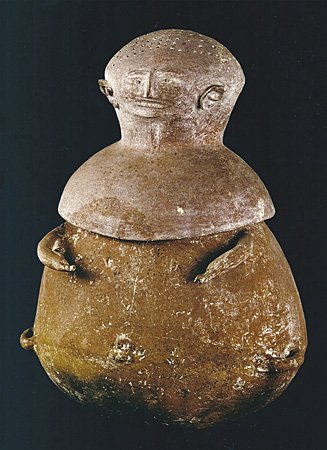Cultural Center of the Philippines
ENCYCLOPEDIA OF
PHILIPPINE ART
[Maitum Jar No. 21]
5 BCE to CE 225 and CE 70 to 370 / Clay / Lid height 179 cm, maximum diameter 20.3 cm; body height 22.7, maximum diameter 26.3 cm / Lid NMP XI-91-P2-130; body NMP XI-91-P2-131 / Ayub Cave, Pinol, Maitum, Saranggani Province, Mindanao, southern Philippines / Collected by Eusebio Z. Dizon and Rey A. Santiago, 1991 / National Museum of the Philippines collection
In 1991, pictures of anthropomorphic burial jars or urns from a cave in Barangay Pinol, Maitum Municipality, Saranggani Province, Mindanao, reached the National Museum. The images caused excitement as such earthenware—shaped into human forms characterized by individualized facial expressions and distinguished by gender and age—had never come out of any Philippine or Southeast Asian site. The secondary burial urn under study, known as the Maitum jar, came from these excavations.
A museum team headed by Eusebio Z. Dizon began to explore what would be called Ayub Cave, named after the Moro National Liberation Front leader who controlled the area. During 1992 and 1995, archaeologists excavated 29 low-fired secondary burial jars in situ, despite the site having been earlier heavily disturbed. Samples from soot taken from a small pot found inside one of the Maitum urns yielded the calibrated radiocarbon dates of 5 BCE to CE 225 and AD 70 to 370, a period straddling the Philippine Late Neolithic and Early Metal Age.
The [Maitum Jar No. 21] represents the most complete of the secondary burial urns in the assemblage. It consists of a jar and lid distinctly portraying a male, which Wilfredo Ronquillo (2011) describes as a child. Except for traces of red hematite (a mineral) on the lips, other surfaces were left unpainted and bore decorative incisions (etchings) and excisions of clay (added on). The lid consists of a head, shoulders, and an impression representing the throat. The head features perforations for hair incisions, well articulated eyebrows, eyes, nose, and incised teeth. The jar bears excisions defining nipples, a penis, a navel, and a pair of arms and legs on either side of the body. The left ear displays the same contour and orientation as the right ear, a peculiar feature.
The lone earthenware pot found inside this urn bears paddle-impressed marks. This small pot contains parts of human bones, including phalanges and deciduous teeth, soil with pebbles, and shells from land snails. Other Maitum finds indicate that these ancient people were selective in the skeletal remains that they used for reburial. Maitum anthropomorphic jars were found in association with an excavated shell spoon, shell bracelets, a Conus (shell) disk and pendant, tanged metal implements, and glass beads. Such artifacts distinguish the higher-ranked in their society and indicate some form of stratification.
How can one compare the Maitum assemblage in southern Mindanao with the famous burial jar from Chamber B of the Manunggul Cave in Palawan? Both emerged in the Late Neolithic Period, both used hematite for painting designs such as S-design scrolls, both employed incised and impressed patterns, and both have come to represent the unique vision and sophisticated artistry of potters from the Late Neolithic period. But while the helmsman and the deceased found on the Manunggul lid represent idealized—ageless, sexless—figures, the Maitum figures come across as individual portraits of males, females, young, old, pregnant, happy, sad, highly ranked or not, among other indicators of how they had been remembered during their lifetime.
Written by Purissima Benitez-Johannot
Sources
Dizon, Eusebio Z. 2003. “Anthropometric Pottery from Ayub Cave, Pinol, Maitum, Sarangani Province, Mindanao.” In Earthenware in
Southeast Asia: Proceedings of the Singaporean Symposium on Premodern Southeast Asian Earthenwares, edited by John N. Miksic, 52-58. Singapore: Singapore University Press, National University of Singapore.
Dizon, Eusebio Z., and Rey A. Santiago. 1996. Faces from Maitum: The Archaeological Excavation of Ayub Cave, edited by Esperanza
Bunag Gatbonton. Manila: National Museum of the Philippines; Museum Foundation of the Philippines Inc.
Ronquillo, Wilfredo P. 2011b. “Maitum Jar (No. 21).” In Paths of Origins: The Austronesian Heritage from the National Museum of the
Philippines, the Museum Nasional Indonesia, and the Rijksmuseum voor Volkenkunde, edited by Purissima Benitez-Johannot, 116-17.
Singapore: ArtPostAsia.
